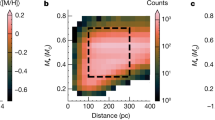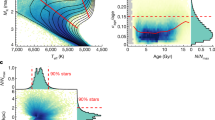Abstract
There is no accepted upper mass limit for stars. Such a basic quantity eludes both theory and observation, because of an imperfect understanding of the star-formation process and because of incompleteness in surveying the Galaxy1. The Arches cluster2,3,4,5,6,7 is ideal for investigating such limits, being large enough to expect stars at least as massive as ∼500 solar masses (∼ 500 M⊙; based on a typical mass function), and young enough for its most massive members to still be visible. It is also old enough to be free of its natal molecular cloud, it is at a well-established distance, and it is close enough for us to discern its individual stars2. Here I report an absence of stars with initial masses greater than 130 M⊙ in the Arches cluster, whereas the typical mass function predicts 18. I conclude that this indicates a firm limit of 150 M⊙ for stars; the probability that the observations are consistent with there being no upper limit is 10-8.
This is a preview of subscription content, access via your institution
Access options
Subscribe to this journal
Receive 51 print issues and online access
$199.00 per year
only $3.90 per issue
Buy this article
- Purchase on Springer Link
- Instant access to full article PDF
Prices may be subject to local taxes which are calculated during checkout


Similar content being viewed by others
References
Elmegreen, B. G. Modeling a high-mass turn-down in the stellar initial mass function. Astrophys. J. 539, 342–351 (2000)
Figer, D. F. et al. HST/NICMOS observations of massive stellar clusters near the Galactic center. Astrophys. J. 525, 750–758 (1999)
Figer, D. F. et al. Massive stars in the Arches cluster. Astrophys. J. 581, 258–275 (2002)
Nagata, T., Woodward, C. E., Shure, M. & Kobayashi, N. Object 17: Another cluster of emission-line stars near the Galactic center. Astron. J. 109, 1676–1681 (1995)
Cotera, A. S. et al. A new cluster of hot stars near the Galactic center. Bull. Am. Astron. Soc. 24, 1262 (1992)
Blum, R. D. et al. 2 micron narrowband adaptive optics imaging in the Arches cluster. Astron. J. 122, 1875–1887 (2001)
Serabyn, E., Shupe, D. & Figer, D. F. An extraordinary cluster of massive stars near the centre of the Milky Way. Nature 394, 448–451 (1998)
Schwarzschild, M. & Harm, R. On the maximum mass of stable stars. Astrophys. J. 129, 637–646 (1959)
Beech, M. & Mitalas, R. Formation and evolution of massive stars. Astrophys. J. Suppl. 95, 517–534 (1994)
Wolfire, M. G. & Cassinelli, J. P. Conditions for the formation of massive stars. Astrophys. J. 319, 850–867 (1987)
Bonnell, I. A., Bate, M. R. & Zinnecker, H. On the formation of massive stars. Mon. Not. R. Astron. Soc. 298, 93–102 (1998)
Bond, J. R., Arnett, W. D. & Carr, B. J. The evolution and fate of very massive objects. Astrophys. J. 280, 825–847 (1984)
Figer, D. F. et al. The Pistol star. Astrophys. J. 506, 384–404 (1998)
Damineli, A. et al. η Carinae: binarity confirmed. Astrophys. J. 528, L101–L104 (2000)
Salpeter, E. E. The luminosity function and stellar evolution. Astrophys. J. 121, 161–167 (1955)
Kroupa, P. The initial mass function of stars: evidence for uniformity in variable systems. Science 295, 82–91 (2002)
Schaller, G., Schaerer, D., Meynet, G. & Maeder, A. New grids of stellar models from 0.8 to 120 solar masses at Z = 0.020 and Z = 0.001. Astron. Astrophys. Suppl. 96, 269–331 (1992)
Najarro, F., Figer, D. F., Hillier, D. J. & Kudritzki, R. P. Metallicity in the Galactic center: The Arches cluster. Astrophys. J. 611, L105–L108 (2004)
Stolte, A., Brandner, W., Brandl, B., Zinnecker, H. & Grebel, E. K. The secrets of the nearest starburst cluster. I. Very Large Telescope/ISAAC photometry of NGC 3603. Astron. J. 128, 765–786 (2004)
Bohannan, B. & Crowther, P. Quantitative near-infrared spectroscopy of OF and WNL stars. Astrophys. J. 511, 374–388 (1999)
Hillier, D. J., Crowther, P. A., Najarro, F. & Fullerton, A. W. An optical and near-IR spectroscopic study of the extreme P Cygni-type supergiant HDE 316285. Astron. Astrophys. 340, 483–496 (1998)
Najarro, F. Massive stars in the galactic center. N. Astron. Rev. 44, 213–220 (2000)
Stolte, A., Grebel, E. K., Brandner, W. & Figer, D. F. The mass function of the Arches cluster from Gemini adaptive optics data. Astron. Astrophys. 394, 459–478 (2002)
Walborn, N. R. et al. A new spectral classification system for the earliest O stars: Definition of type O2. Astron. J. 123, 2754–2771 (2002)
Figer, D. F., McLean, I. S. & Morris, M. Massive stars in the Quintuplet cluster. Astrophys. J. 514, 202–220 (1999)
Figer, D. F. & Kim, S. S. in Stellar Collisions, Mergers and their Consequences (ed. Shara, M.) 287–295 (ASP Conf. Ser. 263, Astronomical Society of the Pacific, San Francisco, 2002)
Weidner, C. & Kroupa, P. Evidence for a fundamental stellar upper mass limit from clustered star formation. Mon. Not. R. Astron. Soc. 348, 187–191 (2003)
Walborn, N. R., Maiz-Apellaniz, J. & Barba, R. H. Further insights into the structure of 30 Doradus from the Hubble Space Telescope instruments. Astron. J. 124, 1601–1624 (2002)
Ramirez, S. V. et al. Stellar iron abundances at the Galactic center. Astrophys. J. 537, 205–220 (2000)
de Boer, K. S., Fitzpatrick, E. L. & Savage, B. D. Abundances of O, Mg, S, Cr, Mn, Ti, Ni and Zn from absorption lines of neutral gas in the Large Magellanic Cloud in front of R136. Mon. Not. R. Astron. Soc. 217, 115–126 (1985)
Acknowledgements
I acknowledge discussions with P. Najarro, R. Larson, N. Walborn, J. Puls, N. Panagia, M. Morris, C. Weidner, P. Kroupa, R. M. Rich, V. Bromm and M. Livio.
Author information
Authors and Affiliations
Corresponding author
Ethics declarations
Competing interests
The author declares that he has no competing financial interests.
Supplementary information
Supplementary Figures 1-4 and Legends
Supplementary Figure 1: The Arches cluster, as imaged in infrared light with the Hubble Space Telescope Near-Infrared Camera and Multi-object Spectrometer. Supplementary Figure 2: Luminosity versus temperature for massive stars. Supplementary Figure 3: Present versus initial mass for massive stars at a variety of ages. Supplementary Figure 4: Results of Monte-Carlo simulation. (DOC 745 kb)
Rights and permissions
About this article
Cite this article
Figer, D. An upper limit to the masses of stars. Nature 434, 192–194 (2005). https://doi.org/10.1038/nature03293
Received:
Accepted:
Issue Date:
DOI: https://doi.org/10.1038/nature03293
This article is cited by
-
1D slipped stacking microribbon-like crystals based on 6,13-dicyanopentacene for ambipolar charge transport
Science China Materials (2023)
-
Nonideal double-slope effect in organic field-effect transistors
Frontiers of Physics (2021)
-
Cosmic feast
Nature Physics (2017)
Comments
By submitting a comment you agree to abide by our Terms and Community Guidelines. If you find something abusive or that does not comply with our terms or guidelines please flag it as inappropriate.



